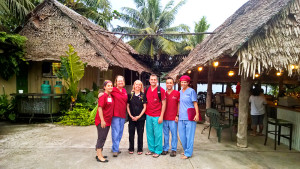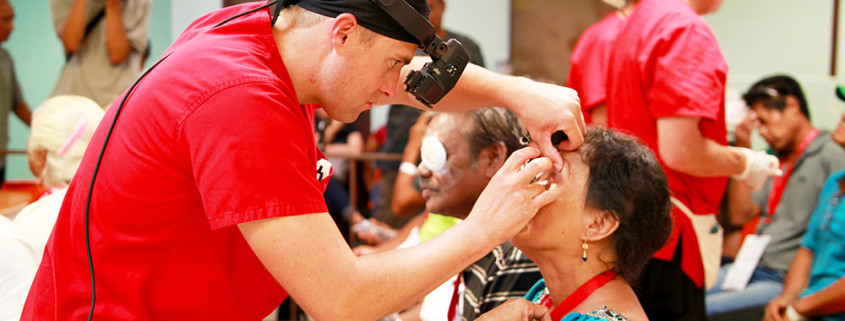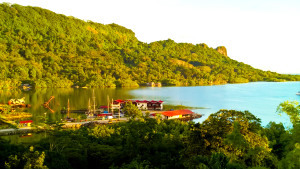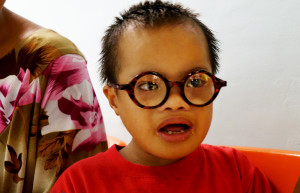Bringing Sight to Micronesia
Dr. Snow Slade of St. George Eye Center recently returned from a humanitarian trip to the geographically isolated island of Pohnpei of the Federated States of Micronesia (FSM). Dr. Slade was one of three eye surgeons on the team sponsored by The Moran Eye Center of the University of Utah. The remainder of the team was comprised of staff from The Moran, as well as volunteers from Guam, Saipan and locals from the island itself.
This was the second time the team from The Moran has done outreach work in Micronesia. During the ten day trip, approximately 200 procedures were performed, including: cataract, glaucoma, and pterygium surgeries, and diabetic lasers. More than 500 patients were screened during that time, and custom glasses were made for those that needed them.
 There are no eye surgeons in the FSM, including in Pohnpei—the largest island of this sovereign group of 607 islands in the North Pacific. The population of Pohnpei is just under 35,000, while the population of the entire FSM is about 110,000.
There are no eye surgeons in the FSM, including in Pohnpei—the largest island of this sovereign group of 607 islands in the North Pacific. The population of Pohnpei is just under 35,000, while the population of the entire FSM is about 110,000.
“It is a tremendous privilege to be part of such a world-class team. We bring first world surgery and technology to the third world and can make a tremendous impact in such a short time,” says Dr. Slade. Over 20 large duffle bags filled with everything one would need to convert a simple outdated hospital room into a first class OR were taken with the team. Truly the Moran team brings the latest in technology with them, including intraocular lens and the latest in operating equipment.
“Bringing in the technology that we do allows us to be efficient and deliver very high quality care that we offer here in the United States,” says Dr. Slade.
The patients themselves recognize the quality. In addition to the Moran team, an Australian team comes to do eye surgery at the same location. The patients, however, prefer the outcomes of the Moran team. Many of the locals forego their options with the Australians and wait for the Moran team to return.
“While our initial goal is to cure as much blindness as we can ourselves, ultimately we plan to train locals to do what needs to be done and turn everything over to them,” says Dr. Slade. Next year, the FSM’s first ophthalmologist, a native of Pohnpei, will start practicing. “Our job then becomes to help train and otherwise support the new doctor,” says Dr. Slade.
The doctors and staff are prepared to do whatever needs to be done while they are there. While they were well prepared for cataract and pterygium surgeries, they went knowing that they would encounter the unexpected.
Dr. Slade recalled a case of a relatively younger man who presented with reduced vision and was found to have early cataracts, with extremely elevated high pressures. “This patient was quite blessed to find this when he did,” said Dr. Slade. “If he had waited until we were back the following year, likely he would have had irreversible vision loss from glaucoma.” Because the doctors were able to intervene when they did, he was able to have cataract and glaucoma surgeries on both eyes, which likely saved him from decades of blindness. The patient was very apprehensive about the surgery initially, and had almost decided against it at the last moment, worried that if something went wrong, he couldn’t take care of his grandchildren whom he was raising. After the surgery, however, the patient was very happy for his new vision, and thanked Dr. Slade profusely.
While glaucoma is essentially non-existent on this island (except for the rare case as noted above) the team found significant diabetic eye disease on this trip. Because so many people presented with vision loss from diabetes, the team was required to adjust their schedule to fit in over two dozen retinal laser procedures to prevent the progression of the disease. “Next year, we plan to ask a retina college to join us to help with the diabetic eye disease,” says Dr. Slade.
According to Dr. Slade, there is story after story like this. “Each person has their story, and it is humbling to get to know many of them. I have been to several different locales across the world, including Africa and Central America, but here in Micronesia I felt like we made some of the largest steps in curing world blindness. There are a finite number of persons on this small island of Pohnpei, and I feel that we really could cure blindness in this remote part of the world.




